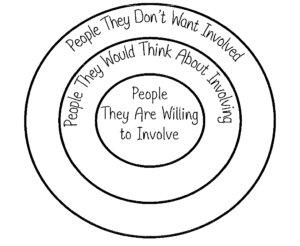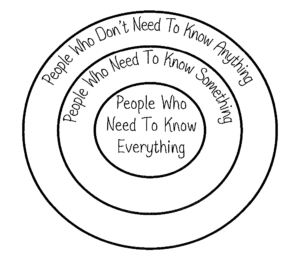(Effective 04/02/19)
Table of Contents
8.2 Inviting People to the Network
Creating Safety Networks
Signs of Safety philosophy is anchored in the aboriginal way of life and reflected in the proverb “it takes a village to raise a child”. Work with parents is an important and needed action to provide safety and wellbeing for children. At the same time it is vital to support that work with a strong network of people that are willing to help the child and family. Where there is not network, there is no safety. This can open up opportunities for families to grow, while at the same time minimizing secrets that make future maltreatment more likely. Natural networks often surround families and know more about them than professionals ever will. When involved in a meaningful way, these networks can and often do stay involved long after professional intervention ends.
Parents and families often have natural supports they can count on. Agency professionals must help support, grow and develop the networks capacity to come around parents and children to ensure future safety. Susie Essex developed The Safety Circles tool to be used to explore with a family those they think could be involved in their safety network.


These tools can and should, and can, be adapted to any family’s particular situation. There may be times where the safety factors are so high that the agency has a bottom line about the safety network composition. If a family cannot think of persons that can be in their network, the agency should use this as an opportunity for exploration. Some questions that can be asked of the family include:
- “So right now you say you do not know anyone who can help you, but we are saying you have to have some people to help you and the kids. What are your ideas about who you could ask?”
- “What are your ideas about how you could ask people to help you?”
- “If you did have some people in your life to help you, what sort of help would you want?”
- “When have you been involved with other people in your life before? How did you meet them?”
- “How could these people help you demonstrate child protection (How can your network show Children’s Division, Court, and your Family Support Team how the children will be safe?).
8.2 Inviting People to the Network
It might seem like a small step, but planning with the parent on how they will approach the people they want in their network is important. It is best for the parent to be clear on what they are asking of their network. The members of the network must understand the child protection issues at hand in order to provide safety to the children in their safety network.
Safety network members ensure safety for the children AND support parents during times of struggle by being actively involved in the family’s day-to-day life. Even family members who have had regular contact in the past must learn to live differently in order to ensure safety in the future. Some other network roles might include helping with laundry, dropping in to visit and brining cookies and checking the children’s safety objects while they are there. Safety network members should never be set up to police the parents because then the parents will have no reason to want the network involved after the case closes. Practitioners should avoid setting the parents and network members up for an adversarial relationship.
A primary role of the network is to develop meaningful relationships with the kids to increase the relational resilience of the children. Children with high relational resilience are much more likely to develop into successful adults in spite of the trauma they experienced as children.
These meetings can be held when needed and involve the network, parent, and agency staff. Children can also attend, depending on the situation. It is critical for the agency to prepare for these meetings and have a clear purpose and game plan for the meeting.
Topics that are often discussed to prepare parents for the first safety network meeting include:
- The importance of involving a network;
- The plan for the meeting: agency and family goals for the meeting, topics that will be covered, key questions for each topic;
- Facilitation of the meeting and strategies for managing possible issues: use of a neutral facilitator, mapping format, possible ground rules;
- Review of danger statements and safety goals;
- How this first network meeting fits into the bigger process of safety planning (number and frequency of meetings);
- Logistics for the meeting: where do the parents and the children feel most comfortable to hold the meeting, when is the best time for the meeting, who will invite the participants (preferably parents if possible)? What information will be shared with the invitees prior to the meeting?;
- Professionals attending and their roles; and
- Children’s involvement/attendance
There are many considerations to make on whether to have children attend safety network meetings. The team must think through the value and purpose of having the child attend. Age, attention span, ability to provide input, and benefits are factors to consider. In general, children should be invited to attend as it is about them.
If a child attends the meeting, it is important to have a network member be assigned to monitor the child and respond to their needs during the meeting. Even if a child does not attend the meeting, the child’s voice and concerns should be shared during the meeting.
Other key questions to prepare for the meeting include:
- What are the main goals for the family and staff at this network meeting? What is their best hope?
- Do the staff and the family already agree on the danger statements and safety goals, or is further discussion needed about this during the safety network meeting?
- How well informed are those who have been invited to the meeting (about the particular situation and role of the safety network)?
- Are there complicating factors staff need to plan around or keep in mind while facilitating the meeting?
- Is the decision about whether and how to involve the child in the meeting acceptable to the agency and consistent with agency policy?
- What has been achieved and what needs to happen next in relation to the Safety Planning Trajectory/Roadmap?
